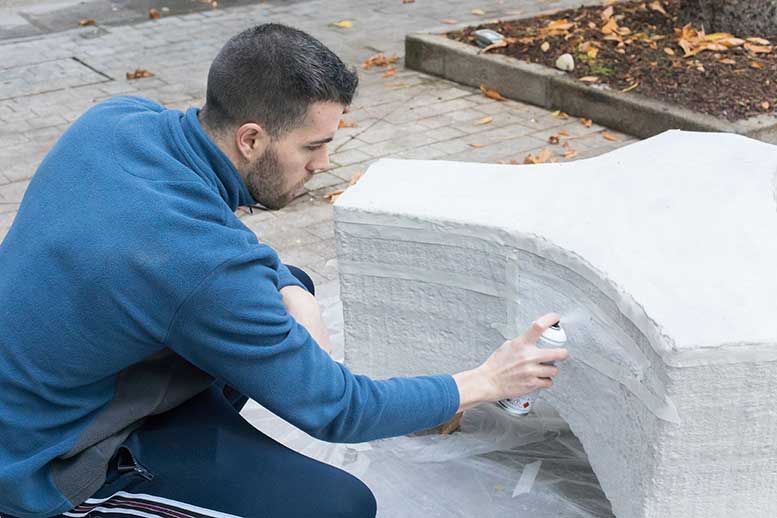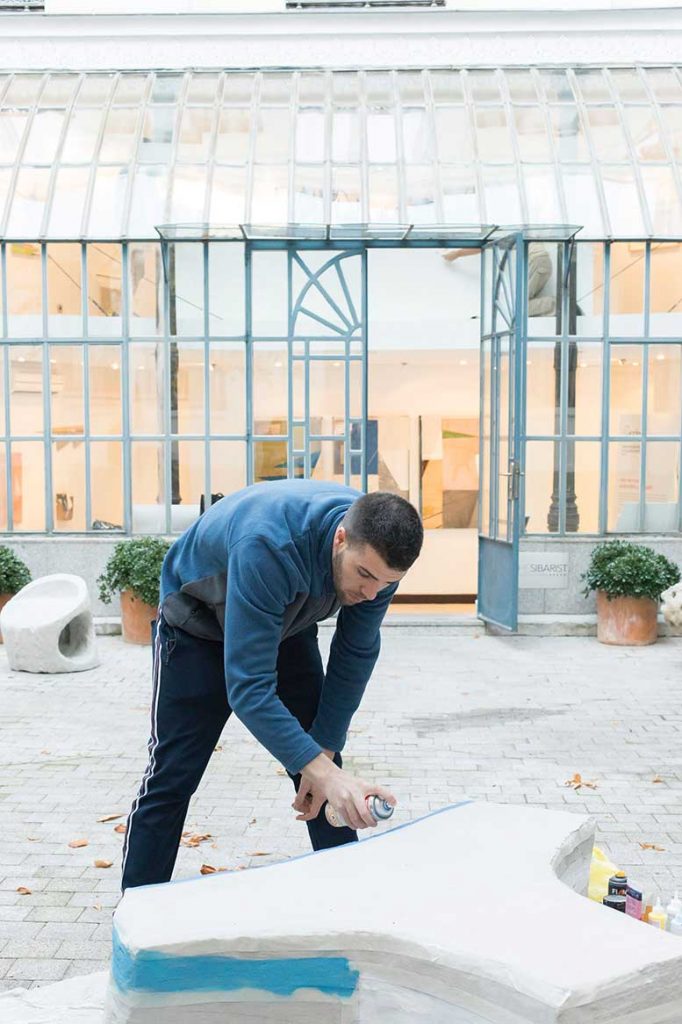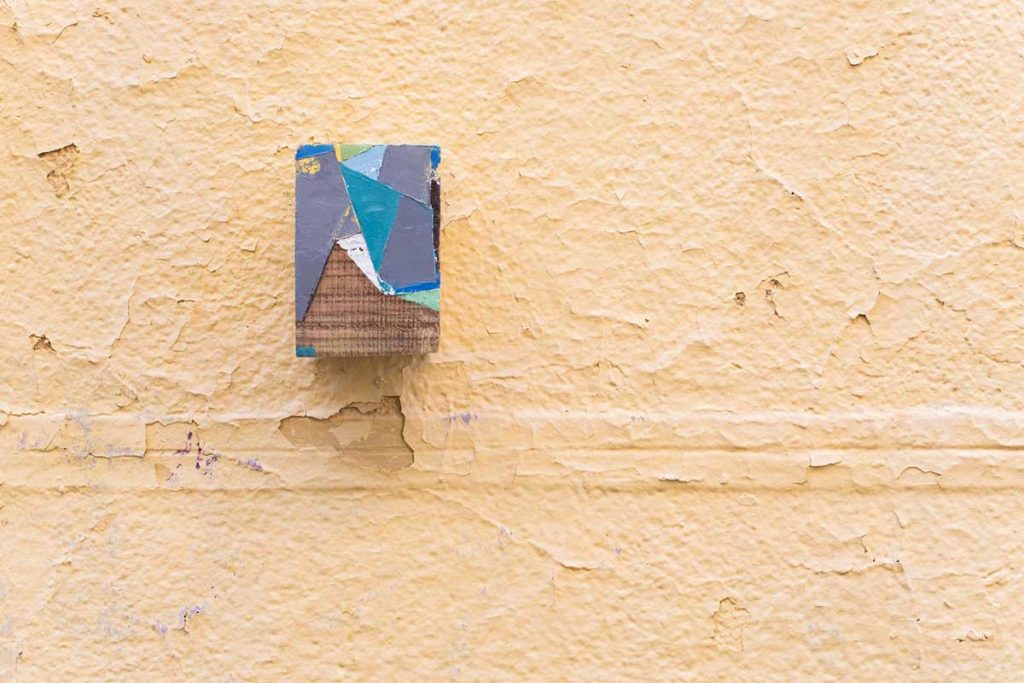Spanish contemporary artist Sergio Femar, talks about sustainable art that reflects the current moment and the constant change of the society we live in, in an interview with Anjali Singh for the Asian Curator.
“I contemplated the idea of recovering materials that others considered as waste and at the same time, I could contribute in some way to the sustainability of the environment”
Spanish contemporary artist Sergio Femar

Artist interview: Sustainable Art
Spanish contemporary artist, Sergio Femar, on becoming an artist.
When I was a teenager, I really enjoyed painting graffiti on the streets just for fun. My friends and I, used to spend the weekend painting walls. That developed an interest within me for painting. And a few years later I enrolled in the Bachelor of Fine Arts course in the University of Salamanca, a distinguished institute of contemporary arts studies in Spain. That is where it all started.
What is the primary role of an artist? How do you describe yourself in the context of challenging people’s perspectives via your work and art?
Each artist has to find his own role and give it sense. My objective as an artist is focused on trying to interpret and represent the society and the world where my generation lives. It is self-referential work.
How do you deal with the conceptual difficulty and uncertainty of creating work?
I normally use construction waste materials to create my artwork.
My role inside the studio is quite intuitive. It involves a constant doing and un-doing in order to find an ‘object’ with certain stylistic characteristics, that at the same time are the result of a process that varies according to the requirements of the material itself. My work is very formalistic.

What would you call your style? Let’s talk about the evolution of your practice over the years. Tell us about your commitment to your current medium.
It is usually over time when a style is named. I would include it as a kind of ‘Post-vandalism’.
In terms of the evolution of my work, it happens naturally and one adapts to certain situations as and when they show up.
I completed my university studies and went to Madrid. I didn’t have many resources so I contemplated the idea of recovering materials that others considered as waste. And at the same time, I could contribute in some way to the sustainability of the environment. That helped make me conscious of the new reality I was in.
Then, the artwork itself lead to new things but it has always been a path that flows without forcing anything.
Let’s talk about your career, or if you prefer, artistic journey. What were your biggest learning and hiccups along the way?
At the creative level and in the way of understanding a painting, the person that helped pave my path at first, was the artist and former teacher Carlos Pascual. He laid most of the foundations upon which I still stand.
At the moment, I am very lucky to converse with people that bring me a lot of positivity and increase my field of action. One of them is the Spanish artist David Rodríguez Caballero, with whom I have a close realtionship and from whom I learn professionally and personally; and the other is cultural curator Paco de Blas, who is expanding my perspectives as a creator.
What are you looking for when you look at other artists’ work? Which shows, performances and experiences have shaped your own creative process? Who are your maestros?
There are many artists that have influenced me in my short career. Carlos Pascual, David Rodríguez Caballero, Robert Motherwell, Franz Kline, Albert Oehlen, Carl Andre, Blinky Palermo, Philip Guston, José Guerrero, Calder are some of them.
Think of the biggest professional risk you’ve taken. What helped you take that risk?
Probably, the greatest professional risk has been the decision to bet my entire future on developing an artistic career, knowing the difficulties involved. I have to thank my parents for the support they have always given me.

Any mentor, curator or gallerist who deserves a special mention for furthering your journey? What is the best piece of advice you’ve received?
My mentors are Carlos Pascual and the curator Paco de Blas, for helping me understand my path.
With respect to gallerists, I would like to mention two: Stéphane Biesenbach, the owner of Galerie Biesenbach, Cologne, Germany, for believing in me from the very beginning and for having taken my work to Germany for the first time. I will never tire of thanking him; and Aurora Vigil-Escalera, the owner of Aurora Vigil-Escalera Galería de Arte, Gijón, Spain, for having been the first gallerist in my country to believe in me. Besides them, I would like to make a special mention to The Sibarist and its platform ArtUReady; for giving me the opportunity for an individual exhibition in Madrid last year with the collaboration and sponsorship of Acciona.
I would also like to highlight several people who have been of great support in recent years; such as Ben Sada, Benin Madrid, Jose and Braulio from Espacio Brut Gallery and the French designer Eric Gallais.
Tell us about your art studio, what kind of a place is it? Could you describe your usual work-day in the studio?
In the last five years, I’ve had four different studios. I still haven’t found the right place to work in. My current studio is located on the top floor of my house. it is the largest space I have had so far.
Lately, I have been working in the afternoons post lunch up until night. I am not a person who lives my life in the studio. I go there, work the hours I want to and then leave. As I am quite obsessive about work, I like to keep my studio and the other places of recreation and my house, separate.

Are you more of a studio artist or naturally collaborative by nature? How do you feel about commissions?
I am a studio artist; it is the place where I am at my best for creation. Getting a place to work is not easy for me the first few weeks, so I consider my studio to be where I get the right ecosystem.
I don’t usually work on commission. It doesn’t quite match up with my creative process. I have done it a few times and I have no problem doing it for certain projects; but they have to be concrete and positive.
What was your first sale? Do you handle the commercials yourself or is it outsourced to a gallery/agent?
My first sale was to my grandmother, just when I returned from Salamanca. She bought one of the paintings that I had made during my fifth year. My first formal sale was a few days later to an Austrian collector.
Presently, my work passes through two galleries: Aurora Vigil-Escalera Galería de Arte in Spain and Galerie Biesenbach in Germany.
What are you working on now? What’s coming next season?
During these months of confinement, I’ve had a lot of time to work indoors and I must say that on a creative level, it has gone well.
I am currently participating in two group exhibitions, one at Galerie Biesenbach called ‘Carte Blanche’ curated by Nicolò Baraggioli, Cologne, Germany and another one at Space52 called ‘Quarantine Exhibition’, Athens, Greece.
I have confirmed a dual show ‘Jux-ta-po-si-ti-on’, also at Galerie Biesenbach next September and I am waiting to see what happens with the art fairs to participate with my gallery Aurora Vigil-Escalera.

What were you working on when the lockdown was announced?
The confinement came at an unstable time for me because I had recently moved from Madrid where I had been residing for the last 6 years to my hometown in Galicia (Spain). I was still adjusting to my new studio when all this happened.
How has this affected your practice and plans?
My plans were affected in that I returned to my birthplace for a short period before moving to Berlin, so it was a bit inconvenient.
My work didn’t change. Once under lockdown, I went into the studio day and night, wanting to work. The streets were really quiet and it was a rare environment that made it posible to concentrate better and create new things. I also had a lot of time to dedicate to reading and it enriched the experience.
My projects were affected. I had a dual show in Madrid at Gärna Art Gallery; the previously mentioned exhibition at Galerie Biesenbach which was scheduled for the end of March and some very interesting plans with Auroral Vigil-Escalera which I cannot reveal.
What would elevate artists’ life during this period?
I think it is a parenthesis that in a way was necessary. We live in a very fast world and it is complicated in the midst of this maelstrom to stop and reflect and to situate oneself better in the world.

What kind of critical inputs does the art world need at this moment to overcome the loss of income and opportunity as a direct result of the lock-downs worldwide?
I believe that the regeneration of the art world will depend largely on the previous work done by different countries. There are countries that have made a great commitment to culture for many generations and those will probably be the ones that are affected the least.
I also believe that this is a moment to reflect on several concepts that I consider unhelpful such as the predominance of quantity over quality, the sometimes cynical use of artists, the disappearance in many cases of critical capacity, the reduction of conditions for original development and growth, or the lack of knowledge in many cases of excellence.
How are you balancing life and work at home during this period?
In my case it was easier than I expected, especially the first month. I came from a very stressful time and it helped me resituate myself and become aware of my needs both as a creator and as a person. The biggest problem was to control the schedules, there came a point where I didn’t know what time I ate or slept and it still affects me a little today.
Before you go – you might like to browse our Artist Interviews. Interviews of artists and outliers on how to be an artist. Contemporary artists on the source of their creative inspiration.












Recent Comments